►►► UWB fire and giants enter the game
The long-rumored NIO phone may be about to be released. According to the official website of the Ministry of Industry and Information Technology, the applicant is Weilai Mobile Technology Co., Ltd., and the mobile phone model N2301 has officially completed the network access. Relevant certification information shows that N2301 supports UWB and can be used as a digital key for Weilai vehicles.
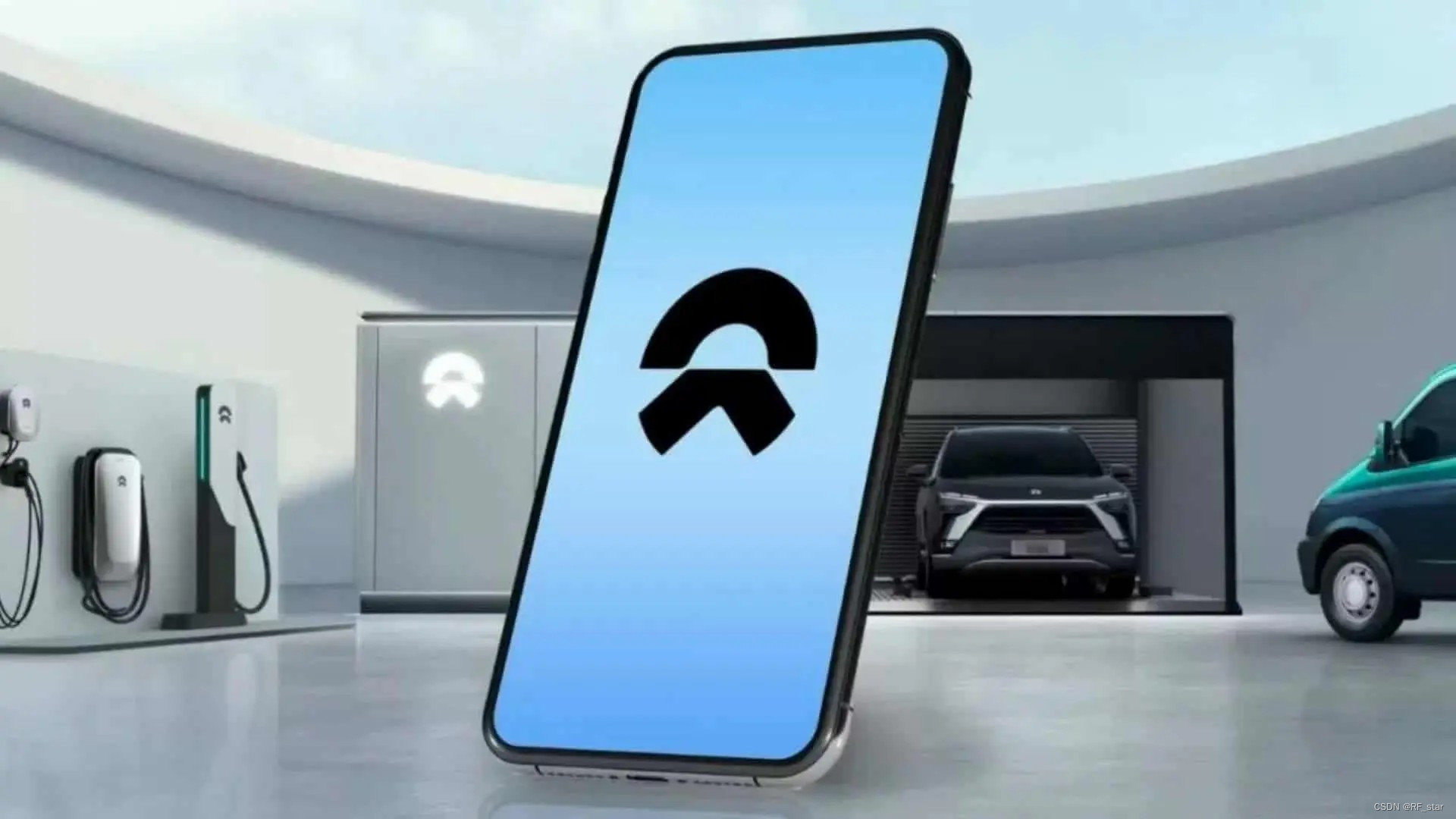
Figure 1 Concept map of NIO mobile phone
What is UWB?
Why are so many mobile phone manufacturers mentioning UWB?
What is a digital key?
It seems that all the new cars released recently are mentioning this concept.
What is the relationship between UWB and digital keys?
If you also have the above questions, Xinchida Technology will soon publish the "Ultra-Wideband (UWB) Knowledge Integration Series Articles" to answer them one by one for you.
UWB is not a new technology, but it really entered the public eye when Apple released the iPhone 11 in 2019. Although Phil Schiller did not mention the U1 chip at the press conference at all, people only saw the U1 chip from the background slide. But it is enough to attract strong attention from the industry. Later, people learned that Apple built the U1 chip into the iPhone 11 to enhance the iPhone’s spatial awareness (Spatial Awareness). The "U" of the U1 chip refers to Ultra-WideBand (UWB).
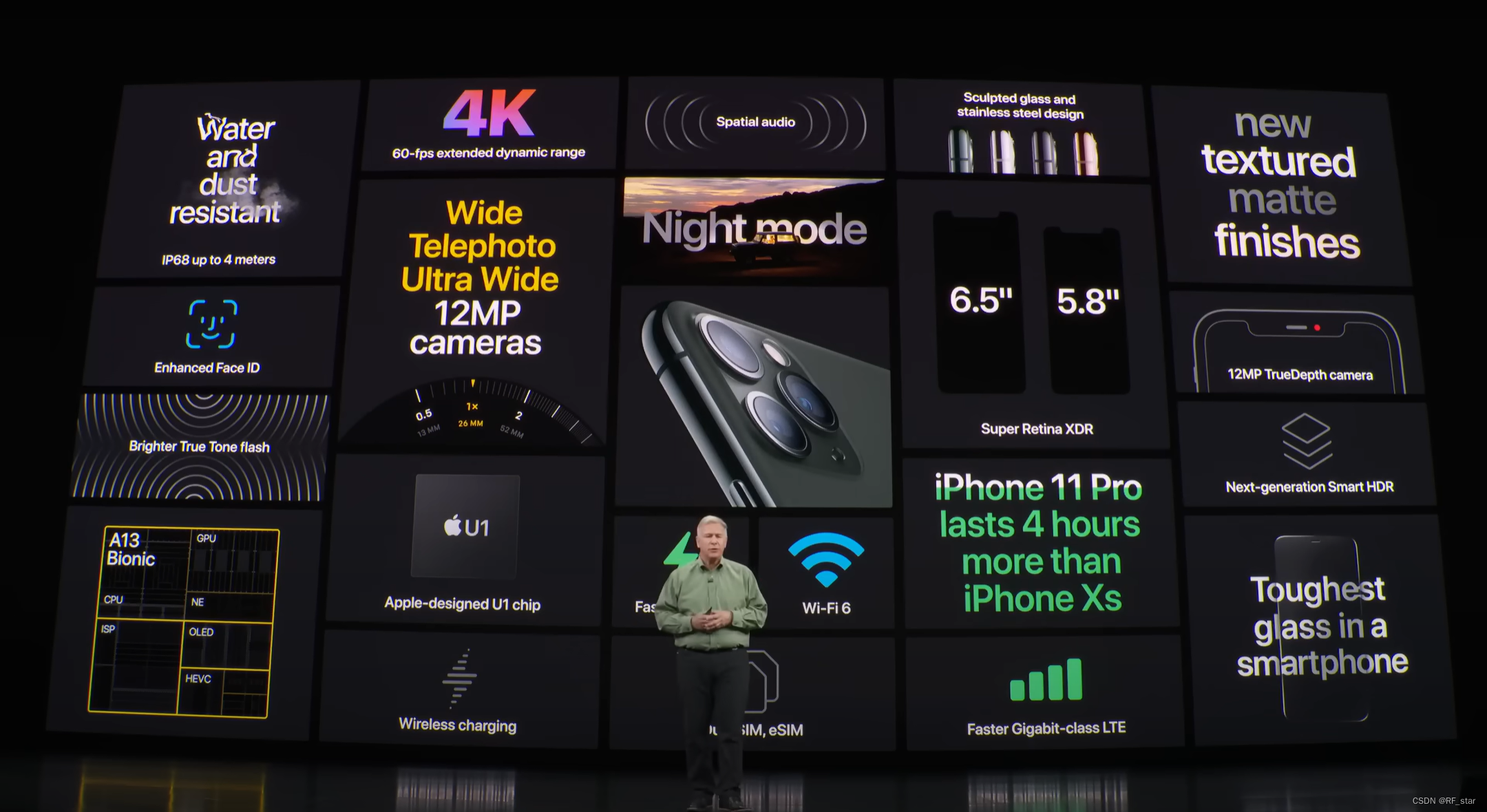
Figure 2 Apple launches U1 chip
Xiaomi also followed closely and released its "one-finger link" technology based on UWB: pointing the mobile phone at a certain smart device can automatically evoke the device's control card for direct control without the need for human selection. Mobile phones and smart devices have spatial awareness capabilities through "one finger connection".
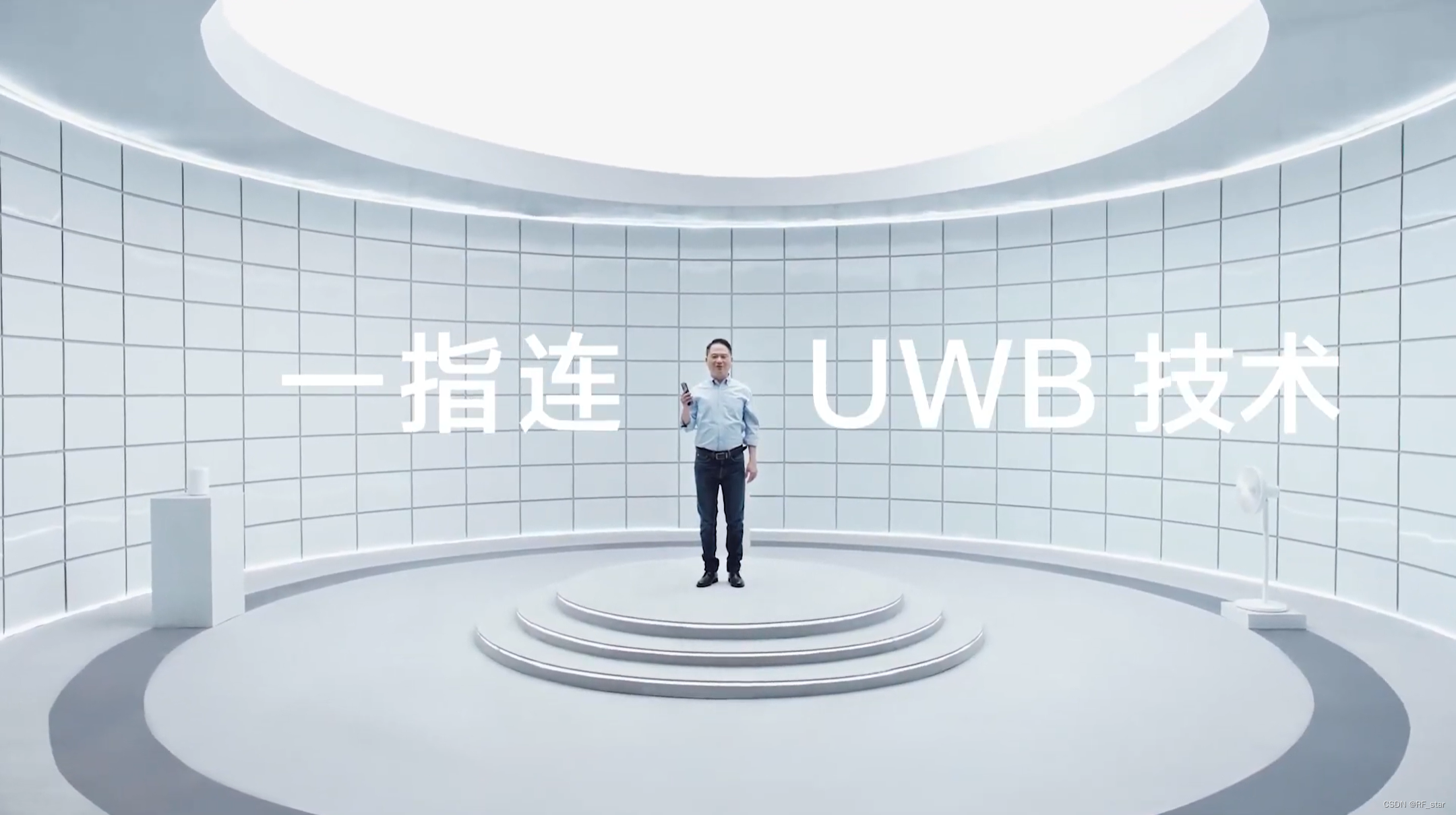
Figure 3 Xiaomi UWB One Finger Link
Samsung also believes that UWB will be a game-changing wireless communication technology. Its flagship Galaxy Note20 Ultra introduces UWB for the first time, adding a new Point to Share function to achieve convenient and efficient file sharing (in fact, it is similar to the AirDrop function of iOS system) .
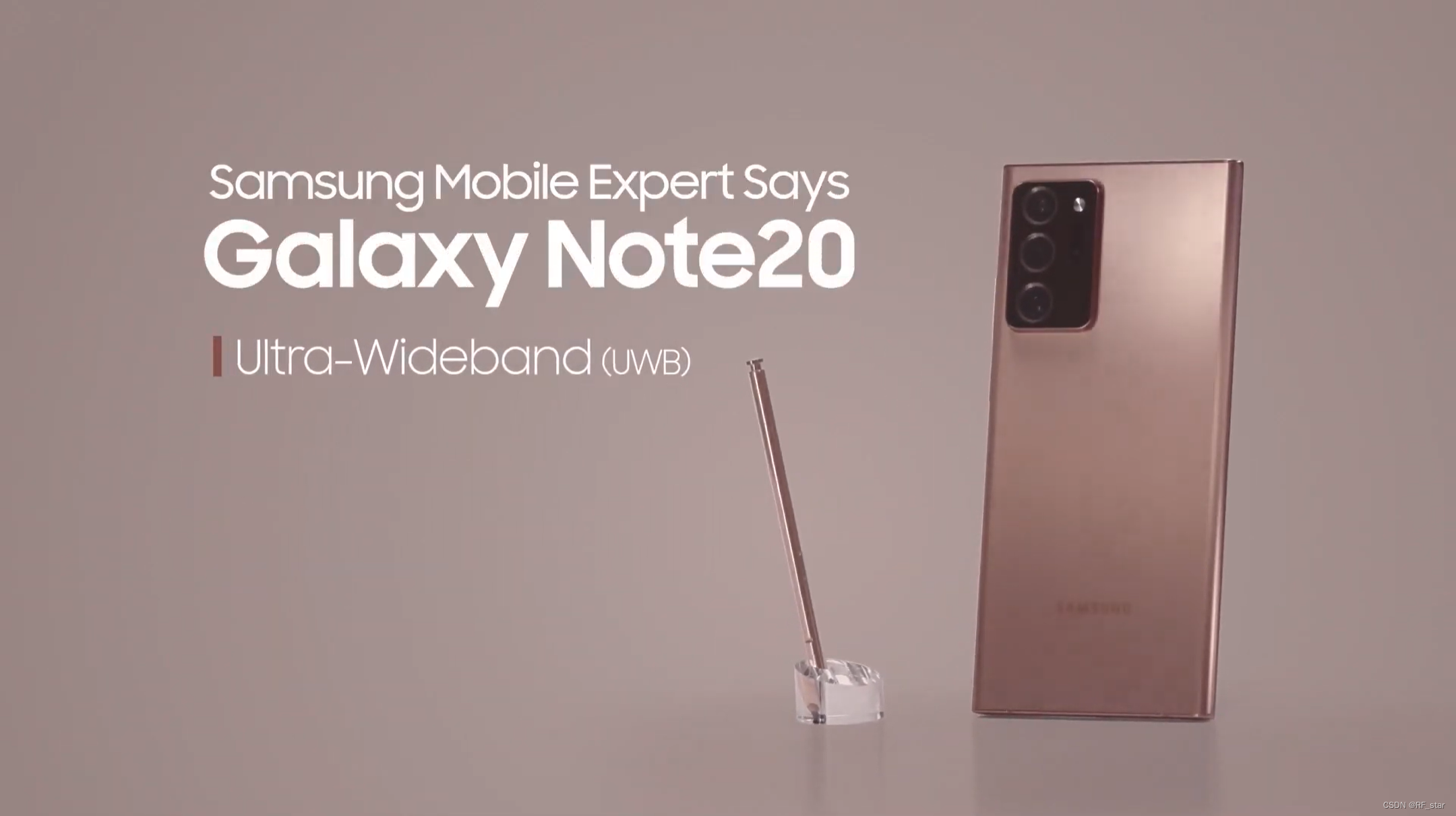
Figure 4 Samsung releases UWB mobile phone
Since iPhone 11, all iPhones have been equipped with U1 chips as standard. In addition to iPhones, Apple has also embedded U1 chips into many of its products (Watch Series 6 and newer versions, HomePod mini, second-generation HomePod, and new AirPods Pro charging cases). and AirTags). Some time ago, Ming-Chi Kuo, "the most powerful Apple analyst on the planet," pointed out that the U1 chip has upgraded its specifications from 16 nm to 7 nm to better support Vision Pro. Apple is paying more attention to UWB technology than ever before.
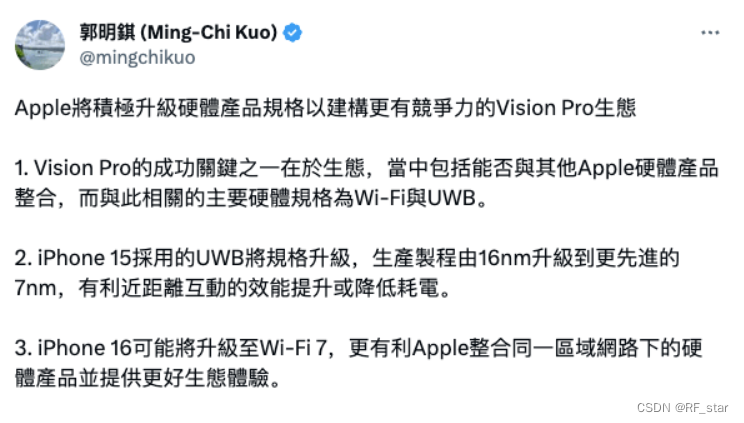
Figure 5 Ming-Chi Kuo’s tweet
In addition to mobile phone manufacturers, car companies have also turned their attention to UWB technology. The long-established car company BMW iX M60 and BMW iX xDrive40 have launched UWB digital keys in the world, and new power NIO ET7 has launched UWB digital keys in China. Recently, new energy giant BYD released the Denza D9, the world's first MPV equipped with UWB digital keys. Both established car companies and new car-making forces emphasize their use of UWB technology.
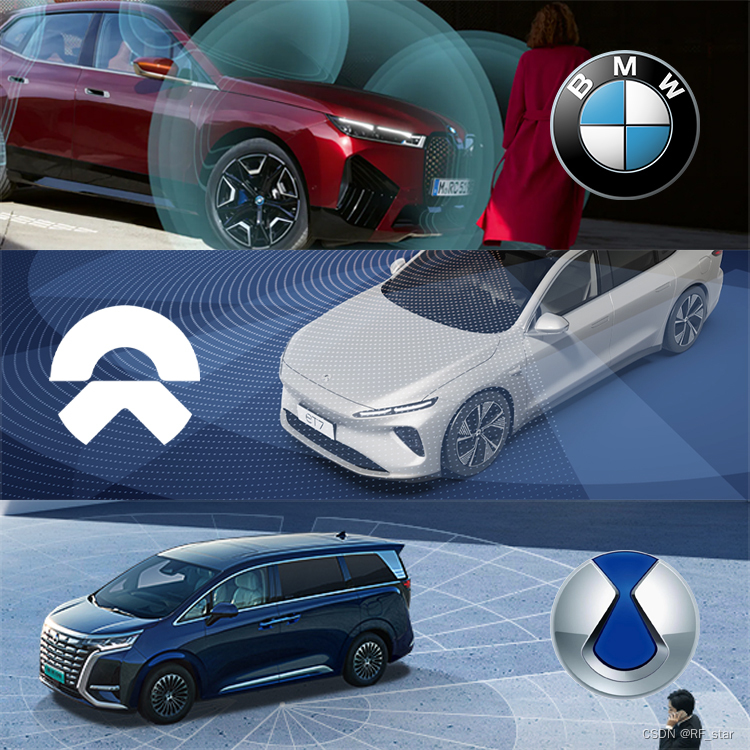
Figure 6 BMW NIO adopts UWB technology
►►► UWB traceability and early research
Tracing the history of UWB (Ultra-WideBand), we have to mention Impulse Radio (IR, Impulse Radio). Because in the early days, UWB was called "pulse radio technology" (also called baseband transmission technology, carrierless transmission technology).

Figure 7 Brief history of the development of pulse radio
Here are three people we should remember:
► In 1887, German physicist Heinrich Hertz confirmed the existence of electromagnetic waves by using a Spark Gap Transmitter to generate pulsed radio.
► In 1893, Nikola Tesla, "the man closest to God", demonstrated to the public the possibility of radio communications using pulse radio.
► In 1901, Italian electrical engineer Guglielmo Marconi used pulse radio to transmit a Morse code sequence 3,500 kilometers across the Atlantic Ocean.
In the modern sense, the research and application of UWB in the field of communication began with the pulse communication technology that emerged in the 1960s:
► Between 1969 and 1984, Harmuth of the Catholic University of America published books and papers that laid the foundation for the design of UWB transceivers.
► Almost at the same time, Ross and Robbins of Sperry Rand Company independently pioneered the use of UWB technology in multiple application fields.
► In 1973, the patent (US Patent 3728632) issued by Ross was an important milestone in the field of UWB communications.
In addition to communications, the research and application of UWB in the field of radar have also been developed at the same time:
► In the late 1950s, the phased array radar system developed by Lincoln Laboratory and Sperry Research Center was the beginning of modern UWB technology research.
► In 1974, GSSI achieved commercial success with the UWB radar system designed by Morey for penetrating the ground.
► In 1977, Paul van Etten of the USAF's Rome Air Development Center conducted experimental tests on the UWB radar system, which promoted the development of UWB system design and antenna concepts.
►►► UWB definition and principle analysis
Since the 1960s, UWB has been one of the combat technologies of the US military.
In 1989, the Defense Advanced Research Projects Agency (DARPA), a subsidiary of the U.S. Department of Defense, first used the term "UWB" and stipulated that if the absolute bandwidth of the signal at -20dB is greater than 1.5GHz or the relative bandwidth If it is greater than 25%, the signal is an ultra-wideband signal.
In 2002, the U.S. Federal Communications Commission (FCC) approved ultra-wideband wireless technology for civilian use and redefined and standardized ultra-wideband signals:
► The absolute bandwidth (B) at -10dB is greater than 500 MHz and the center frequency (fC) is greater than 2.5 GHz, or the relative bandwidth (Bfrac) is greater than 0.2 and the center frequency (fC) is less than 2.5 GHz. Where fC=(fH+fL)/2, B=fH-fL, Bfrac=B/fC
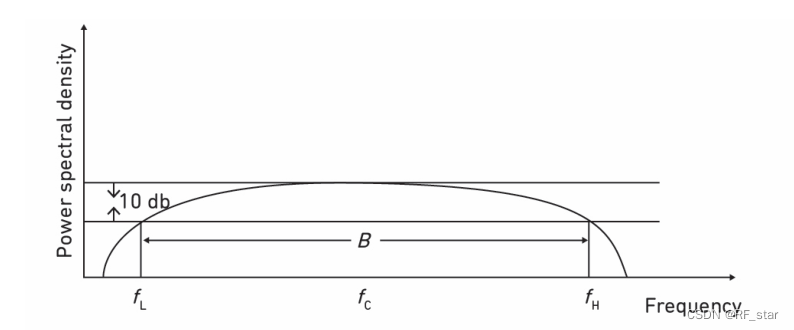
Figure 8 UWB schematic diagram
► Frequency range is between 3.1 GHz and 10.6 GHz with radiated power limit of -41.3dBm
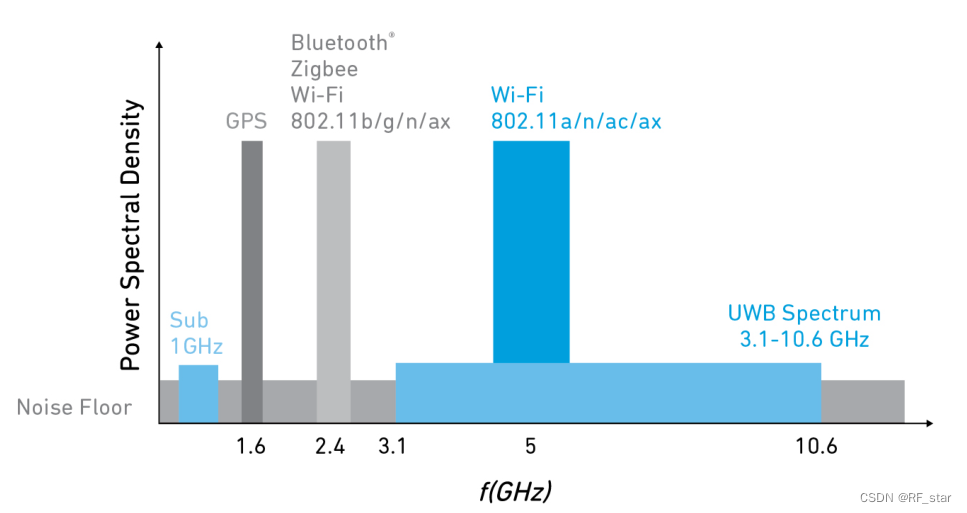
Figure 9 UWB bandwidth comparison
Traditional wireless communication uses radio frequency (RF, Radio Frequency) carriers to transmit signals, and uses the frequency and power of the carrier to change within a certain range to transmit information. UWB uses pulse radio for signal transmission. Pulse radio can send up to 1 billion pulse signals representing 0 and 1 per second. The time domain of these pulse signals is extremely narrow (nanosecond or picosecond level) and the frequency domain is extremely wide. (several Hz to several GHz), the low-frequency part of which can achieve through-wall communication (radar applications). The transmit power of the pulse signal is extremely low, even lower than the background noise, and will basically not interfere with other narrowband signals.

Figure 10 UWB pulse waveform
Through the analysis of UWB signal principles, it is not difficult to find the following advantages of UWB:
► Large channel capacity: UWB bandwidth is above 500 MHz. According to Shannon's formula, the wider the bandwidth, the greater the channel capacity.
► High transmission rate: UWB can achieve data transmission rates of hundreds of Mbit/s to several Gbit/s within a range of about 10 meters.
► Low transmission power: UWB signal transmission power is low, energy consumption is low, and the radiation hazard to the human body is almost negligible.
► High multipath resolution: UWB signals have strong temporal and spatial resolution, are not sensitive to channel attenuation, and have strong anti-attenuation capabilities.
► Good system confidentiality: The power spectral density of UWB signals is lower than ordinary environmental noise, making UWB signals difficult to identify.
► High positioning accuracy: The characteristics of the UWB signal enable its distance resolution accuracy to reach centimeter level.
► Strong penetrating ability: UWB narrow pulse has strong penetrating ability and can penetrate obstacles and identify objects hidden behind obstacles.
►►► UWB Standards and Alliance Organization
IEEE 802.15.3a
Due to the huge development potential and broad application prospects of UWB, the UWB standard debate has become very fierce since the FCC approved UWB for civilian use in 2002. By early 2003, the Institute of Electrical and Electronics Engineers (IEEE, Institute of Electrical and Electronics Engineers) ) when it started formulating IEEE 802.15.3a, it received more than 20 UWB solutions. After going through market screening, the final remaining UWB solutions are mainly:
► MB-OFDM solution led by Intel and Texas Instruments.
► DS-CDMA solution led by Motorola and XtremeSpectrum.
However, neither of these two plans passed the final vote of IEEE. Moreover, because the two UWB solutions, MB-OFDM and DS-UWB, are essentially different and incompatible with each other, IEEE 802.15.3a cannot unify the two solutions. In 2006, IEEE disbanded the 802.15.3a working group.
IEEE 802.15.4a
At the same time as the IEEE 802.15.3a technical standard was formulated, the IEEE 802.15.4a standard also began to be formulated. From 2007 to the present, UWB technology is mainly evolving in the IEEE 802.15.4 standard working group. The 2011 version was finally completed and this standard is IEEE 802.15.4a-2011. In 2018, for security reasons, IEEE 802.15.4a-2011 was upgraded to IEEE 802.15.4z. The latest IEEE 802.15.4z standard defines two UWB physical layer specifications: LRP (Low Rate Pulse) and HRP (High Rate Pulse).
At present, the important organizations promoting the development of UWB are:
► IEEE Standards Association (IEEE Standards Organization): UWB is part of the IEEE 802.15.4 standard. Within IEEE, it is maintained by the 802.15 TG4Z working group. It is responsible for the research on the physical layer of the UWB standard and the related ranging technology of the MAC layer, mainly Members include: NXP, Apple, Decawave, Samsung, etc. It is worth mentioning that Michael McLaughlin, co-founder of Decawave, is a member of the team of engineers who created the IEEE 802.15.4a standard.
► UWB Alliance: Committed to providing a strong regulatory and spectrum management environment to maximize the development of UWB. Strong engagement in optimizing spectrum sharing while minimizing interference. Advocate for coexistence in the expanding wireless multiverse and work with members and stakeholders to provide thought leadership on the strategy of “Making Everything Work Together.” It aims to promote vertical industries to demonstrate the value of UWB for the Internet of Things and Industry 4.0, and build a global ecosystem covering the entire UWB value chain from chips to services. (Core members include: Bosch, Qorvo, KIA, Ubisense, Xiaomi, etc.)
► FiRa Consortium (FiRa Alliance): The name FiRa stands for "fine ranging" and is pronounced "fee-rah", highlighting the unique ability of UWB technology to provide unprecedented accuracy and security when measuring target distance or determining location. The vision is to change the way we interact with our environment by providing precise location awareness to people and devices. Designed to provide a broad range of product and solution companies with a way to quickly resolve ecosystem and interoperability challenges to achieve mutual success in the future. (Core members include: Apple, Bosch, Cisco, Google, NXP, Qorvo, Qualcomm, Samsung, etc.)
► Car Connectivity Consortium (CCC Alliance): Create a sustainable and flexible ecosystem to standardize the interface between vehicles and smartphones. Designed to provide a consistent user experience across all vehicles and mobile devices by increasing interoperability and reducing market fragmentation. Representing most of the global automotive and smartphone industries, the mission is to bring all relevant industries together to set industry standards for future vehicle-to-smartphone connectivity solutions. CCC facilitates the connectivity of mobile devices, services and applications in the integrated operation of automotive information, communications and entertainment systems. Coordination between mobile device OEMs and vehicle OEMs to create products that are easy to use, convenient, secure and privacy-protected, and have a wide range of features. (Core members include: Apple, Xiaomi, BMW, Ford, GM, Google, NXP, Mercedes-Benz, Volkswagen, Samsung, etc.)
► PROFIBUS & PROFINET International (PI International): omlox is the world's first industrial-grade open positioning technology standard launched by PI International. It aims to implement flexible real-time positioning solutions using components from different manufacturers, using the technology defined by omlox , UWB-based devices from different manufacturers can be located in a positioning area and can integrally map the location information of complementary positioning technologies. (Core members include: Accenture, Amazon, Kaos, Inspur, Qorvo, Siemens, etc.)
Domestic UWB-related organizations are mainly in the direction of vehicle-machine interconnection:
► Intelligent Connected Vehicle Industry Ecological Alliance (ICCE): Focuses on bringing together the strengths of all parties in the industry to jointly carry out research and application promotion of application scenarios, needs, technologies, and standards related to mobile terminals and automobile interconnection and collaboration, and promote technology, industry, and application research and development Combining them to form a good cooperation atmosphere and collaboration mechanism, carry out extensive exchanges and cooperation with domestic and foreign manufacturers, and strive to build a global cooperation platform to achieve win-win results. The main areas of focus include but are not limited to car data, digital car keys, mobile intelligent terminal-car interconnection collaboration, etc. The alliance adheres to the principle of technology neutrality, and the technical route of the business direction is jointly decided by the working group after its establishment. (Core members include: China Association of Automobile Manufacturers, Huawei, CAICT, BYD, Dongfeng, Great Wall, GAC, Geely, SAIC, etc.)
► Intelligent Car Connectivity Open Alliance (ICCOA): With three mobile phone manufacturers, Xiaomi, OPPO, and Vivo, as the initiators, it unites domestic mainstream car companies and industry-related Tier 1, based on the innovative development of mobile phone-car interconnection. With the mission of gathering the strength of the smart car and machine industry and jointly building an open and collaborative ecology of smart car connectivity, it carries out research and application promotion of relevant scenarios, technologies, and standards for smart terminals and car interconnection collaboration to realize mobile phones and cars, technology and data, The deep integration of hardware and software reduces industry fragmentation, promotes interconnection between mobile terminals and cars, and improves user experience. (Core members include: Xiaomi, OPPO, vivo, Changan, Geely, and SAIC.)
► Internet Financial Identity Authentication Alliance (IIFAA): The development of the alliance is increasingly integrated with industry trends, and has gradually formed a new mission of "focusing on the construction of trusted digital identities and connecting the infinite possibilities of the digital world", and exploring the future of digital identity with ecological partners. Technological innovation, scene changes and business opportunities empower users to safely navigate the digital world. At present, we are vigorously promoting the formulation of multiple security standards related to the application of voiceprint recognition, digital car key applications in smart travel scenarios, and the application of face recognition in remote account opening, self-service customs clearance and other scenarios. Through alliance co-creation, we can make up for the gaps in the standard field. Blank spots provide reference for safety indicators for industry applications. (Core members include: Academy of Information and Communications Technology, Ant Financial, Huawei, Samsung, Alibaba, and ZTE.)
Those who have historically contributed to the development of UWB are worth mentioning:
► MBOA Alliance (Multiband OFDM Alliance): Committed to submitting MB-OFDM UWB technology to IEEE 802.15.3a as a standard proposal for UWB technology in the name of the alliance. The alliance has more than 50 members at its most, all of which are important manufacturers in consumer electronics, personal computers, semiconductors, digital imaging and other fields. Since the UWB technology of IEEE 802.15.3a was ultimately not completed, MBOA was finally merged with WiMedia.
► WiMedia Alliance: Committed to cooperating with IEEE 802.15.3a in the research and promotion of high-speed UWB. IEEE 802.15.3a is committed to the research and formulation of high-speed UWB low-level standards, and WiMedia is committed to the research and formulation of high-speed UWB high-level standards. Later, due to the failure of the IEEE 802.15.3a standard, it merged with MBOA. In 2009, WiMedia transferred all specifications to the Bluetooth Special Interest Group (SIG), Wireless USB Promoter Group and USB Implementers Forum. The WiMedia Alliance ceased operations in 2010.
►►► UWB functions and application fields
According to the characteristics of UWB, its basic functions are divided into: data transmission, radar imaging, ranging and positioning.
► In terms of data transmission, the industry had high hopes for UWB for short-distance wireless transmission. However, in 2009, Wi-Fi technology, which was also a competitor, developed rapidly and quickly seized the short-distance wireless transmission market. UWB finally withdrew from the wireless personal area network (WPAN) transmission stage. There have been many studies on UWB for wearable device communication in the industry. But in 2013 Bluetooth Low Energy (BLE) became the mainstream connection technology for wearable devices. Because the amount of data transmitted between wearable devices and smartphones at this stage is not large, the advantages of UWB are difficult to reflect in practical applications.
► In terms of radar imaging, UWB radar has always been the mainstream solution for searching for casualties after wars and searching and rescuing people after earthquakes or landslides. UWB bioradar can achieve non-contact, long-distance detection of breathing and heart beating information of a living body without the need for conductors or sensors to contact the living body. UWB radar uses the Doppler effect of wireless signals to detect changes in the surrounding electromagnetic environment, and determines whether there is movement or living breathing through the characteristics of changes in the electromagnetic environment. UWB radar can be used as a living radar and kick radar in the vehicle body domain, which can effectively improve vehicle safety and convenience.
► In terms of ranging and positioning, UWB has been rediscovered by the market with its centimeter-level ranging and positioning capabilities, which is not unrelated to people's growing demand for real-time positioning services (RTLS). From preventing the loss of small items to monitoring sensitive personnel or valuable materials, from car digital keys to autonomous valet parking (AVP). At present, major mobile phone manufacturers and OEMs, as well as enterprises in all aspects of the industry chain, are aiming at the application of UWB ranging and positioning to make corresponding innovations.
Based on the basic functions of UWB mentioned above, we can roughly divide UWB application fields into three major categories: consumer electronics, smart cars, and industrial applications:
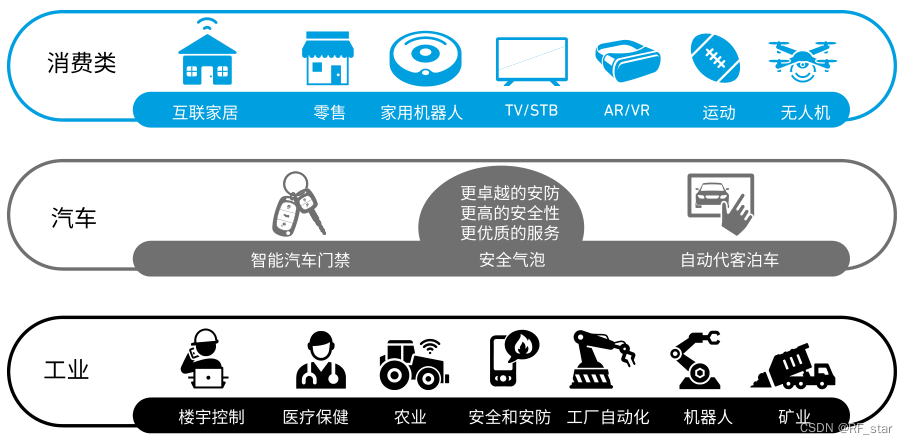
Figure 11 UWB application areas
► Consumer electronics field: smartphones, smart homes, new retail, augmented reality (AR)/virtual reality (VR), and sports events.
Apple equips all iPhone 11 and later models with UWB chips as standard. AirPods, HomePod, etc. also have built-in UWB chips. Apple upgraded the UWB chip to support the newly released VisionPro; UWB can track the rapid movement of athletes and has been used in many professional sports events. used in.
► Smart car field: digital key, biometric radar, kick radar, autonomous valet parking (AVP)
The digital key uses UWB technology to prevent relay attacks, thereby improving vehicle security. The installation of UWB modules in the body domain can greatly improve the user experience; UWB applications in parking lots can realize autonomous valet parking.
►Industrial application areas: factory workshops, industrial robots, mining, warehousing and logistics.
The industrial field is the earliest ToB application of UWB in China. Factories and coal mines use UWB to accurately locate personnel and materials, thereby improving safety and operational efficiency; UWB tags can track forklifts and tools to view work progress in real time, thus helping Improve workflow efficiency.
About Xinchida
Shenzhen Xinchida Technology Co., Ltd. (RF-star) is a high-tech company specializing in RF communication solutions for the Internet of Things. When it was founded in 2010, it became the official authorized solution provider of TI in the United States. Later, it successively obtained products from Silicon Labs, Nordic, Recognition and support from well-known chip companies at home and abroad such as Realtek and ASR. The company provides IoT wireless modules and application solutions, including BLE, Wi-Fi, UWB, Wi-SUN, LoRa, Zigbee, Thread, Matter, etc.